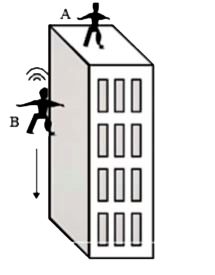Which frequency produces a sound that can be heard by a person?
100 kHz
40 kHz
2 kHz
30 kHz
The correct Answer is:C
To determine which frequency produces a sound that can be heard by a person, we need to consider the range of human hearing. The typical range of human hearing is from approximately 20 Hz to 20 kHz (20,000 Hz).
1. Understanding Human Hearing Range:
- The human ear can generally detect sounds in the frequency range of 20 Hz to 20 kHz. Frequencies below 20 Hz are considered infrasound, and those above 20 kHz are considered ultrasound.
2. Analyzing the Given Options:
- The question provides several frequency ranges and asks which of these can be heard by a person.
- Options include:
- 100 kHz
- 20 kHz
- 100 kHz to 20 kHz
- More than 20 kHz
- 40 kHz
- 2 kHz
- 20 Hz and then 20 kHz
- 30 kHz
3. Identifying Frequencies within the Hearing Range:
- From the options:
- 100 kHz: Above the hearing range (not audible).
- 20 kHz: Upper limit of the hearing range (audible).
- 100 kHz to 20 kHz: Includes frequencies above the hearing range (not audible).
- More than 20 kHz: Not audible.
- 40 kHz: Not audible.
- 2 kHz: Within the hearing range (audible).
- 20 Hz and then 20 kHz: Both are within the hearing range (audible).
- 30 kHz: Not audible.
4. Conclusion:
- The frequencies that can be heard by a person from the given options are 2 kHz and the range 20 Hz to 20 kHz.
Final Answer:
The frequencies that produce a sound that can be heard by a person are 2 kHz and 20 Hz to 20 kHz.
- The human ear can generally detect sounds in the frequency range of 20 Hz to 20 kHz. Frequencies below 20 Hz are considered infrasound, and those above 20 kHz are considered ultrasound.
- The question provides several frequency ranges and asks which of these can be heard by a person.
- Options include:
- 100 kHz
- 20 kHz
- 100 kHz to 20 kHz
- More than 20 kHz
- 40 kHz
- 2 kHz
- 20 Hz and then 20 kHz
- 30 kHz
- From the options:
- 100 kHz: Above the hearing range (not audible).
- 20 kHz: Upper limit of the hearing range (audible).
- 100 kHz to 20 kHz: Includes frequencies above the hearing range (not audible).
- More than 20 kHz: Not audible.
- 40 kHz: Not audible.
- 2 kHz: Within the hearing range (audible).
- 20 Hz and then 20 kHz: Both are within the hearing range (audible).
- 30 kHz: Not audible.
- The frequencies that can be heard by a person from the given options are 2 kHz and the range 20 Hz to 20 kHz.
The frequencies that produce a sound that can be heard by a person are 2 kHz and 20 Hz to 20 kHz.
Topper's Solved these Questions
Similar Questions
Two cars are approaching each other on a straight road and moving with a velocity of30kmh−1. If the sound produced in a car is of frequency 500 Hz, what will be the frequency of sound as heard by the person sitting in the other car ? When the two cars have crossed each other and are moving away from each other, what will be the frequency of sound as heard by the same person ? Speed of sound= 330ms−1.
View SolutionTwo cars are approaching each other on a straight road and moving with a velocity of 30kmh−1.if the sound produced in a car is of frequency 500 Hz, what will be the frequency of sound as heard by the person sitting in the other car ? When the two cars have crossed each other and are moving away from each other.what will be the frequency of sound as heard by the same person ? Speed of sound =330ms−1.
View Solution
Knowledge Check
A train, blowing a whistle of frequency f, is standing in the railway yard A person is running towards the engine. The frequency of the sound of the whistle as heard by the person will be
Agreater than fBless than fCequal to fDgreater or less than f depending on the speed of the train.A person B accidentally slips from a large building and screams with a sound of constant frequency v as he falls as shown in the figure. What will be apparent frequency of the second of the scream as heard by the person A, at the top of the building as a function of time?
 Av'=v(vv−gt)Bv'=v(vv+gt)Cv'=v(2v2v−gt2)Dv'=v(2v2v−gt2)
Av'=v(vv−gt)Bv'=v(vv+gt)Cv'=v(2v2v−gt2)Dv'=v(2v2v−gt2)The frequency of sound waves which can be heard by human is _______.
Aless than 20 HzBgreater than 20 kHzCbetween 20 Hz and 20 kHzDNone of these
Two cars P and Q are approaching each other with velocities of 36 km/h and 72 km/h respectively.
The frequency of a note emitted by car P as heard by the person sitting in car Q is 850 Hz. What will be the frequency of note heard by person sitting in car P ? Velocity of sound = 340 m/s.
View SolutionTwo sounds of very close frequencies 510Hz and 514Hz are produced simultaneously. What is the frequency of resultant sound? How many beats can be heard in 5sec?
View SolutionThe frequency of sound waves which can be heard by human is _______.
View SolutionWhich of the following frequencies of sound can't be heard by human beings?
View SolutionWhich of the following frequencies of sound cannot be heard by human beings?
View Solution
